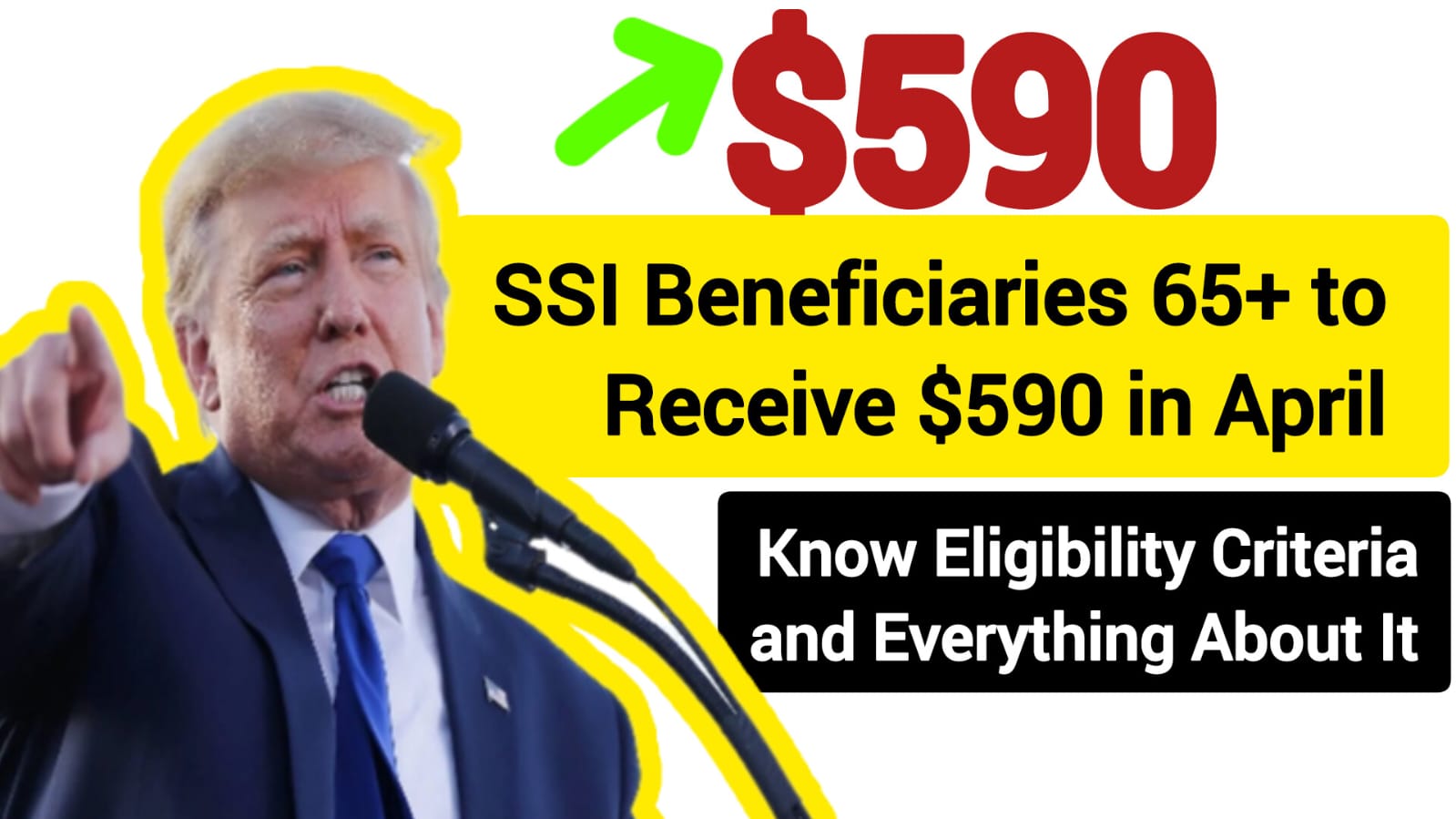Are you or a loved one over 65 and struggling to make ends meet on a fixed income? There’s good news on the horizon. As living costs continue to rise across America, Supplemental Security Income (SSI) recipients are receiving critical financial support to help manage everyday expenses. The SSI program, designed specifically to assist elderly, blind, and disabled individuals with limited resources, provides monthly payments that can make a significant difference in recipients’ lives.
In this comprehensive guide, I’ll walk you through everything you need to know about the $590 payment for SSI beneficiaries aged 65 and older, including eligibility requirements, payment schedules, and how to make the most of this financial assistance. Whether you’re already receiving SSI or wondering if you might qualify, this article will help you navigate the complexities of this vital support program.
Understanding SSI Payments for Seniors in 2025
Supplemental Security Income (SSI) serves as a financial lifeline for millions of Americans who have limited income and resources. Unlike regular Social Security benefits, which are based on your work history and the taxes you’ve paid, SSI is a needs-based program designed to provide basic financial support regardless of your work history.
For 2025, the SSI program continues to provide essential monthly support with updated payment amounts. The standard federal benefit rate for SSI recipients has increased to $967 per month for individuals and $1,450 for couples, thanks to the 2.5% Cost-of-Living Adjustment (COLA) implemented in January 2025. This modest increase helps recipients maintain their purchasing power as inflation continues to affect everyday expenses.
But what about the $590 payment? This amount represents a potential partial payment or supplement that some SSI beneficiaries aged 65+ might receive under specific circumstances. This could be part of a state supplement, retroactive payment, or advance payment option. The exact nature and eligibility for this $590 payment depend on various factors including your state of residence, living arrangements, and specific financial situation.
SSI Payment Schedule for April 2025
If you’re an SSI recipient, understanding when your payments will arrive is crucial for managing your monthly budget. For April 2025, SSI payments will be distributed on Tuesday, April 1, 2025. Unlike regular Social Security benefits, which are paid based on birth dates throughout the month, SSI payments typically arrive on the first day of each month.
However, there’s an important scheduling quirk to be aware of: when the first of the month falls on a weekend or federal holiday, payments are issued on the last business day of the previous month. This explains why there was no separate SSI payment in March 2025 – the payment for March was actually issued on Friday, February 28, 2025, since March 1 fell on a Saturday.
Looking ahead, SSI recipients will receive two payments in May 2025 – one on May 1 for May, and another on May 30 for June (since June 1 falls on a Sunday). This pattern of early payments continues throughout the year whenever the first falls on a weekend or holiday.
Who Qualifies for SSI Benefits at Age 65+?
To qualify for SSI as a senior aged 65 or older, you must meet specific eligibility criteria related to age, residency, income, and resources. Let’s break down these requirements:
Age and Residency Requirements
The age requirement is straightforward – you must be 65 years or older. Additionally, you must:
- Be a U.S. citizen or national, or fall into certain categories of qualified aliens
- Be a resident of one of the 50 states, the District of Columbia, or the Northern Mariana Islands
- Not be absent from the country for a full calendar month or for 30 consecutive days or more
- Not be confined to an institution (such as a hospital or prison) at the government’s expense
Income and Resource Limits
SSI is specifically designed for those with limited financial means. To qualify, your income and resources must fall below certain thresholds:
Income Limits:
- Your “countable income” must fall below the Federal Benefit Rate (FBR), which is $967 for individuals and $1,450 for couples in 2025
- Not all income is counted – the SSA has complex rules about what income affects your eligibility
Resource Limits:
- Individuals: Maximum resources of $2,000
- Couples: Maximum resources of $3,000
Resources include cash, bank accounts, stocks, bonds, and property that can be converted to cash for food and shelter. However, certain assets are exempt, including:
- Your primary residence
- One vehicle (usually)
- Household goods and personal effects
- Burial plots and burial funds up to $1,500
- Life insurance policies with a combined face value of $1,500 or less
It’s worth noting that the SSA regularly reviews any changes in a recipient’s income, assets, or living situation, which may affect the benefit amount or result in a suspension of payments.
How to Apply for SSI Benefits
If you believe you meet the eligibility criteria for SSI and want to apply for benefits, here’s a step-by-step guide to help you navigate the process:
Gather Required Documentation
Before starting your application, collect the following documents:
- Proof of age (birth certificate or passport)
- Social Security number
- Proof of U.S. citizenship or eligible non-citizen status
- Proof of income (pay stubs, tax returns, bank statements)
- Proof of resources (bank statements, vehicle registration, insurance policies)
- Information about your living arrangement (mortgage, lease, utility bills)
- Medical records if you’re also applying based on disability
Submit Your Application
You have several options for applying:
- Online: Visit the SSA website to start the application process
- Phone: Call the SSA at 1-800-772-1213 (TTY 1-800-325-0778) from 8 a.m. to 7 p.m. Monday through Friday
- In-person: Schedule an appointment at your local Social Security office
The application process can be complex and time-consuming, so don’t hesitate to ask for help from a family member, friend, or social worker. The SSA also provides free assistance to help you complete your application.
| SSI Payment Information for 2025 | Details |
|---|---|
| Standard Monthly Payment (Individual) | $967 |
| Standard Monthly Payment (Couple) | $1,450 |
| Resource Limit (Individual) | $2,000 |
| Resource Limit (Couple) | $3,000 |
| April 2025 Payment Date | April 1, 2025 |
| May 2025 Payment Dates | May 1 and May 30, 2025 |
| Application Methods | Online, Phone (1-800-772-1213), In-person |
| COLA Increase for 2025 | 2.5% |
Maximizing Your SSI Benefits
Once you’re approved for SSI, there are several strategies to ensure you’re receiving the maximum benefit amount you’re entitled to:
Report Changes Promptly
The SSA requires you to report any changes that might affect your eligibility or benefit amount, including:
- Changes in income or resources
- Changes in living arrangements
- Marriage, divorce, or death of a spouse
- Leaving the country for 30 days or more
Reporting these changes promptly helps avoid overpayments that you might later have to repay.
Explore State Supplements
Many states offer supplemental payments on top of the federal SSI benefit. These supplements vary widely by state and can significantly increase your monthly payment. States known for providing substantial supplements include California and New York. Contact your state’s social services agency to learn about additional benefits you might qualify for.
Check for Other Benefits
SSI recipients often qualify for additional assistance programs, including:
- Medicaid for healthcare coverage
- Supplemental Nutrition Assistance Program (SNAP) for food assistance
- Housing assistance through HUD
- Home energy assistance programs
- Tax credits and property tax exemptions
Think of these programs as pieces of a financial safety net – when combined, they provide much more comprehensive support than any single program alone.
Conclusion
The SSI program provides vital financial support for Americans aged 65 and older who have limited income and resources. While the standard federal benefit rates for 2025 are $967 for individuals and $1,450 for couples, specific payments like the $590 amount mentioned may represent state supplements, partial payments, or special circumstances that apply to certain beneficiaries.
Understanding the eligibility requirements, payment schedule, and strategies for maximizing your benefits can help you make the most of this important program. Remember that SSI is designed to be one part of a broader safety net – combining it with other assistance programs can provide more comprehensive support for your needs.
If you think you might qualify for SSI, don’t hesitate to apply. The application process may seem daunting, but the potential financial support is well worth the effort. And if you’re already receiving SSI, stay informed about payment schedules and program changes to ensure you continue receiving the benefits you’re entitled to.
FAQs About SSI Benefits for Seniors
1. How is the $590 payment related to regular SSI benefits? The $590 payment likely represents a partial payment, state supplement, or special circumstance payment rather than the standard federal SSI benefit. The exact nature of this payment depends on factors like your state of residence, living arrangements, and specific financial situation. Contact your local Social Security office for details about how this payment might apply to your specific case.
2. Can I receive both SSI and regular Social Security retirement benefits? Yes, it’s possible to receive both SSI and Social Security retirement benefits if your Social Security benefit is low enough that you still meet the income requirements for SSI. Approximately half of SSI recipients also receive Social Security benefits. However, your Social Security income will reduce your SSI payment amount.
3. How often does the SSA review my eligibility for SSI? The SSA conducts periodic reviews to ensure you still meet the eligibility requirements for SSI. These reviews typically occur every 1-6 years, depending on your circumstances. During a review, you’ll need to provide updated information about your income, resources, and living arrangements.
4. What happens if I leave the United States while receiving SSI? Generally, if you leave the United States for 30 consecutive days or more, you’re no longer eligible for SSI payments. Your payments will stop and you’ll need to reapply when you return. There are some exceptions for certain countries with which the U.S. has agreements, but these exceptions are limited.
5. How do I check the status of my SSI application or payment? You can check the status of your application or payment by:
- Creating or logging into your my Social Security account online
- Calling the SSA at 1-800-772-1213 (TTY 1-800-325-0778)
- Visiting your local Social Security office (appointment recommended) If you’re expecting a payment that hasn’t arrived, the SSA recommends waiting three additional mailing days before contacting them, as 99% of payments are made electronically and typically arrive on time.



